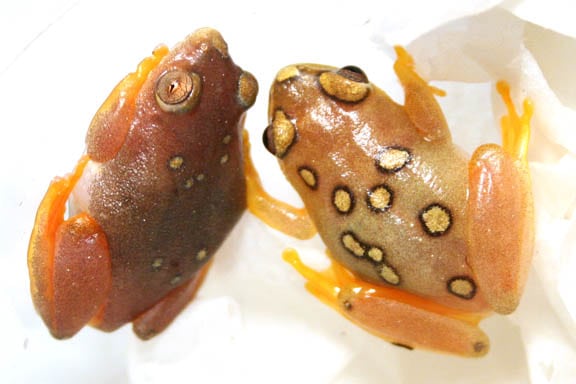Type the name of the breed you're looking for below
[wpdreams_ajaxsearchlite] Don't see the breed your're looking for? Click here and let us know!
African Reed Frog
| Place of Origin and Range | Common names Argus reed frog, Argus sedge frog, and Boror reed frog (and many others) is a hyperolid frog found in the eastern coastal plain of Africa from southern Somalia through Kenya, Tanzania, Mozambique, Malawi, Zimbabwe to KwaZulu-Natal in eastern South Africa |
| Description | Adult males are usually green, and females usually reddish-brown with large white spots. The colouration and pattern show geographic variation.Both females and males metamorphose to a solid green colour without spots—the color of adult males. Under experimental conditions, the time from metamorphosis to the change to a female color pattern took about two months; for a male, the time from metamorphosis to the development of vocal sacs, with spontaneous vocalization and aggression, was about three months. |
| Adult Size | Can grow up to 1 in(2.5 cm) |
| Accommodation | These frogs "prefer habitats with plentiful floating vegetation, grasses, and cattails" and are often found in "small ponds, large lakes, marshes, and streams also can be found at night in a backyard swimming pool. Unlike many amphibians, they do not require artificial heating. They need a large (at least ten-gallon) terrarium and do best with a substrate that will hold some humidity, such as commercial shredded bark or coconut husk bedding, or untreated topsoil on the floor of their terrarium. A shallow water dish should be included. Captive frogs should not be handled any more than necessary; when necessary, clean gloves should be worn. . A source of UV light is not required, and ambient temperature of 72 to 77 °F (22 to 25 °C) is sufficient. |
| Lifespan | Can live 5+ years |
| Feeding / Diet | These frogs are insectivores, usually consuming flies, mosquitoes, and other small insects such as crickets. One study suggested the frog selects prey not by its size, but according to its activity level, with the most active prey being the most frequently eaten. |



